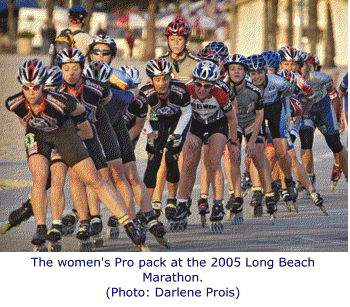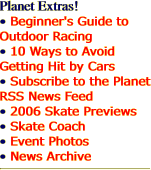 |  | |||||||||||||||||||||||||||||||||||||||
 | ||||||||||||||||||||||||||||||||||||||||
The Beginner's Guide to Outdoor Racing > Part 2 Drafting and Pacelines Q&A: I like skating alone — why should I skate in a paceline? It's way more fun than skating alone — think of being part of a school of fish or a flock of birds. Besides, you'll go faster in a paceline. You can go the same speed with up to 30 percent less effort. So it's an easy way to cut 10-20 minutes off your marathon time.
Really, it's a lot like driving on the freeway. Once you get attuned to the predictable traffic rhythms, it's so easy you can do it while eating, talking or fiddling with your iPod. How close should I be to the person in front of me? Put your arm out in front of you with your palm vertical, like you were a traffic cop signaling "Stop." Now bend your elbow down until it hits your ribs. While drafting with your arm in this position, your fingers would be on the lower back of the person in front of you. The length of your forearm — elbow to wrist — is all you need to keep your skates out of the way of the person in front of you. If you have to extend your arm all the way and/or lean forward in order to touch the person in front of you, you are not in the draft and should get closer. How do I keep my skates from tangling with the person in front of me? It's like dancing. Your feet move in tandem. You stay in step with the person in front of you by sight and feel, rocking side to side along with them to match strokes. Gently modulate the amount of muscle in your stroke so that you stay about a forearm's length away. If you "roll up" on them, put your hand on their lower back and give them a light push forward, just enough to keep the space between you. If you get further away, add a tiny bit more power to your push. You will get a feel for it quickly. How do I watch the feet in front of me and watch the road at the same time? Don't watch anyone's feet! You'll never be able to react in time. Instead, keep your eyes up and moving, just like you would when driving. Look at the shoulders of the people in front of you and match their rhythm. That will get your feet in step. Sweep your eyes up the road, over their shoulders, to see what's coming. If they are tall and you are short, poke your head out above or to the side every few seconds while staying in the draft. Am I really supposed to put my hand on the person in front of me? That's kind of weird. Don't worry — experienced racers are used to it, and soon you will be, too. But here are some rules of etiquette: Push on the small of the back, or if the skater in front of you is bent low, right above the butt. Push only forward, never to the side, and never down toward the pavement. Don't hang onto a skater's hips — once you have acquired a feel for the correct following distance, get in the habit of keeping your hands on your own back and touching the skater in front of you only when necessary. Don't get in the habit of using the flat of your palm to push — if you trip, you'll reflexively grab and take somebody down with you. Use your fingertips or make a fist and use your knuckles or the side of your fist to push. Don't take it personally if skaters ask you to push them in different spots — different pokes for different folks. Should I lead? Absolutely! A cooperative pack changes leads frequently, allowing the leader to pull off to the side and hook onto the back of the line. It's your turn to lead when the person in front of you pulls over. Suddenly you'll feel the pressure of the wind, but don't speed up in response — that will make it harder for the previous leader to get back on. Keep a steady pace, something that is comfortable for you, even if it feels like you are slowing down. If the person behind you touches you more frequently, it doesn't mean you ought to speed up — it's normal when you are getting pushed by the wind and the person behind you isn't. If someone wants to take the group faster, they will fly up from behind and take over for you. After about a minute (count 60 strokes), you are free to get off the lead, though if it's a social skate or you feel strong, you can lead longer or more frequently. How do I get off the lead? Be decisive. Give a strong push and zoom off to the side of the paceline. Then let it go by you, but don't coast — if you keep your feet moving it will be easier to get back on. When you are even with the last person in line, give another strong push and zoom back into line. This can be tricky if you are going fast, so never change leads on a downhill. What about pavement hazards, sudden turns, etc.? Part of the fun of a social paceline is everyone yelling out, "Hole!" Leaders will clearly point out turns to the side, point down at pavement hazards, and signal for traffic. If a traffic light is green you will hear "Clear!", and if you have to stop the leaders will yell and raise their arms over their heads. If we have to stop, what do I do? Never T-stop or use your brake to slow down in the paceline without warning — if it's time to stop, throw your hands up and fan out across the available pavement to give your fellow skaters lots of room to execute their stops. You should never need to stop in a race; nevertheless, you should be confident about stopping before you try paceline skating in street traffic. Go to: Part 1 - Race Categories Part 2 - Drafting and Pacelines Part 3 - Race Dynamics and Interval Training Part 4 - Race Day: Fashion, Food and Packing Part 5 - Getting More Involved in Racing | Discuss Sections: Part 1 - Race Categories Part 2 - Drafting and Pacelines Part 3 - Race Dynamics and Interval Training Part 4 - Race Day: Fashion, Food and Packing Part 5 - Getting More Involved in Racing | |||||||||||||||||||||||||||||||||||||||
... Copyright © 2006 by Robert Burnson | ||||||||||||||||||||||||||||||||||||||||

